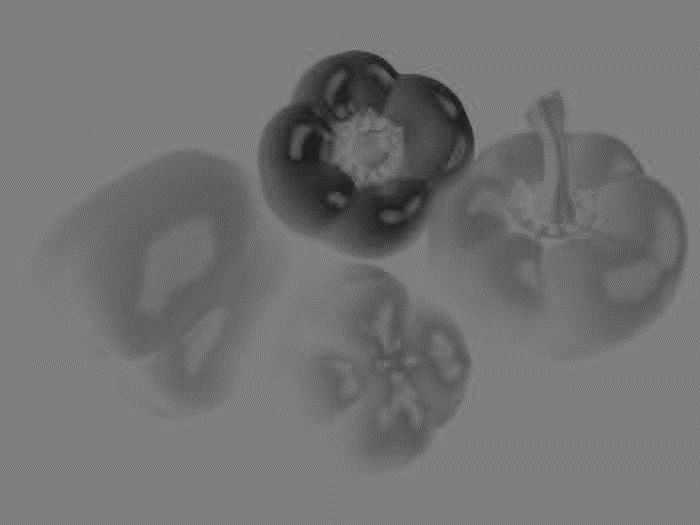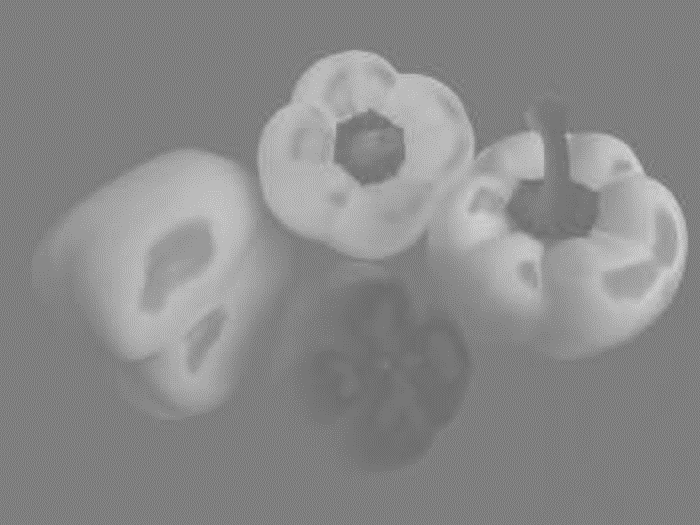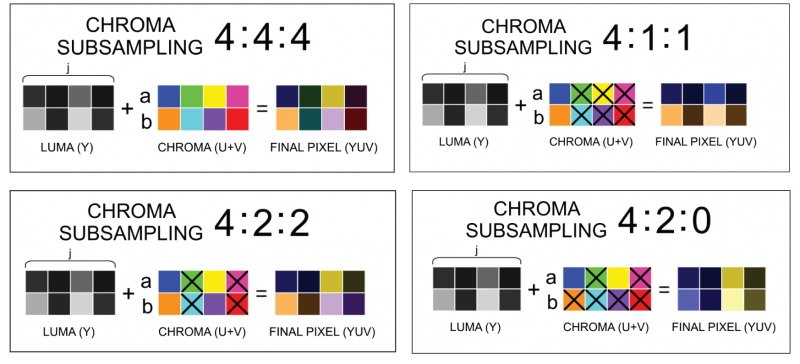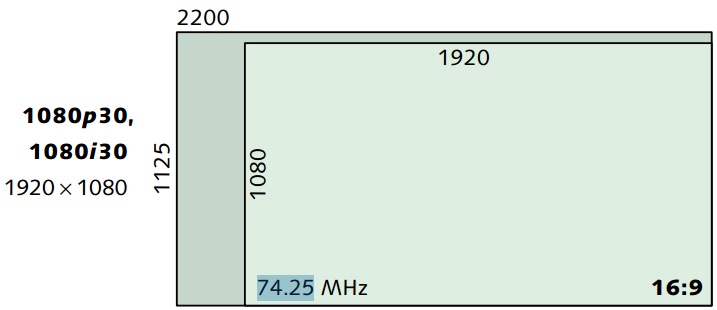What are Color Space, Color Sampling, 1.5Gb/s and 3Gb/s?

In this article, I want to explain a few topics that I’ve been planning to write about for a long time and about which I’ve received many questions. I’ll be sharing answers to common questions such as: What is 4:2:2? What is 4:2:0? What is 1.5 Gb/s? What is 3Gb/s? Let’s start with the color space, which is fundamental to these topics.
RGB Color Space
In the RGB color space, the color value of each pixel is stored in separate channels. For example, in an 8-bit video, 3 bytes (8 bits x 3 channels) of color value are stored for each pixel. There is no separate brightness information in the RGB color space. Therefore, it is not possible to compress color and brightness information separately.

Original image
R G B



Some RGB video formats are also generally converted to YUV using ready-made conversion matrices before compression, and reverse conversion is performed during reading.
Y’/Cb/Cr (YUV)
It’s not exactly a color space like RGB, but rather a different way of representing the RGB color space. In this method, color information (chroma) can be compressed at different rates with independent processes as it is separated from brightness information (luma).
The human eye perceives the black/white tones in an image, i.e., brightness information (luminance), more predominantly, while it is not as sensitive to color information. Therefore, color information, which is more tolerated compared to brightness information, can be compressed at a higher rate, reducing the bandwidth used.
Luma (Y’) information is obtained by the weighted sum of the gamma-compressed color channels in an image, namely R’, G’, and B’ values, and is represented by Y’. The reason for different weights of color channels in the image is the different sensitivities of the human eye to different colors. According to the ITU (International Telecommunication Union) standard, it is calculated with the formula Y’=0.299R’ + 0.587G’ + 0.114B'.
Cb (U) represents the difference between the information in the gamma-compressed B’ (Blue) channel of the RGB image and Y’ (U = B’-Y’). According to the ITU standard, it is calculated as Cb=-0.169R – 0.331G +0.499B + 128.
Cr (V) represents the difference between the information in the gamma-compressed R’ (Red) channel of the RGB image and Y’ (V = R’-Y’). According to the ITU standard, it is calculated as Cr=0.499R – 0.418G - 0.0813B + 128.

Original image
Y’ Cb (U) Cr (V)



Commonly Used Color Sampling Ratios:
Color information used separately from luma information is generally reduced by sampling for bandwidth savings. The sampling ratios used are expressed as three values separated by “:” characters in the form of J:a:b. (If it’s a format containing Alpha information, J:a:b:Alpha is used. For example, 4:4:4:4)
The notation showing the sampling does not directly express the bandwidth allocated for Y/Cb/Cr used in the format. (It should not be concluded that there is no Cr in 4:2:0 video)
The sampling ratio references a rectangular area J pixels wide (generally accepted as 4) and 2 pixels high, containing 8 pixels.
J: Width of the reference area (generally 4) a: Number of pixels containing color information in the first row of sampling. b: Number of pixels containing color information in the second row of sampling.
So in a video in 4:2:0 format, there are 2 pixels containing color information in the first row of an 8-pixel sampling area. The absence of color information in the second row indicates that the information from the first row will be used for the lower value as well.

-
4:4:4 All channels contain full resolution information without sampling. It is preferred in areas where quality is needed, such as cinema post-production, high-quality film scanning.
- HDCAM SR SQ
- DNxHD 444
- Apple ProRes 4444
-
4:2:2 Used in many high-level broadcasting formats. It contains full color information resolution horizontally and half color information resolution vertically. Example formats:
- AVC-Intra 100
- Digital Betacam
- DVCPRO50 and DVCPRO HD
- Digital-S
- CCIR 601 / Serial Digital Interface / D1
- ProRes (HQ, 422, LT, and Proxy)
- XDCAM HD422
- Canon MXF HD422
-
4:2:0 Contains half resolution horizontally and vertically.
- DVD-Video, Blu-ray Disc
- PAL DV, DVCAM
- HDV
- AVCHD, AVC-Intra 50
- Apple Intermediate Codec
- JPEG/JFIF and MJPEG based codecs
- VC-1
What are 1.5 Gb/s and 3 Gb/s?
After the commonly used color samplings, let’s now examine what 1.5 Gb/s and 3 Gb/s signals are;
In standard definition (SD), both PAL and NTSC accept 2.25 MHz as the Lowest Common sampling frequency. We obtain the Luma (Y) frequency as 6 x 2.25MHz = 13.5 MHz, and we will use this frequency to reach the bandwidth value required by a standard definition signal;
Let’s calculate the Bandwidth of a 10-bit SD signal with 4:2:2 color sampling using the formula (Y + Cb + Cr ) x 10bit = max. bit-rate.
Y: 13.5 x 10 bit = 135 Mb/s
Cb: 13.5/2 x 10 bit = 67.5 Mb/s
Cr: 13.5/2 x 10 bit = 67.5 Mb/s
---------------
**270 Mb/s**
We see that a signal in standard definition (SD) with 4:2:2 color sampling and 10 bits requires a bandwidth of 270 Mb/s. We can find the bandwidth required by a High Definition (HD) signal using the same formula, but in the HD signal, the Luma frequency value will be 74.25 MHz. Let’s see how we reach this 74.25 MHz value;
For 1125 vertical scan lines in 16:9 aspect ratio, there are 2002 horizontal scan lines. Based on this information, we obtain a frequency of 67.57 MHz by calculating 2002 x 1125 x 30 (frame rate). However, since this value is not exactly divisible by 2.25 MHz, we base on 74.25 MHz to use horizontal scanning as an integer, resulting in 2200 horizontal scan lines, although 1920 horizontal scans are sufficient for an image.

Now that we have obtained our 74.25 MHz frequency, we can find the bandwidth of an HD signal;
Y: 74.25 x 10 bit = 742.5 Mb/s
Cb: 74.25/2 x 10 bit = 371.5 Mb/s
Cr: 74.25/2 x 10 bit = 371.5 Mb/s
---------------
1.485 Gb/s
We find the bandwidth required by an HD signal by taking the bandwidth value of 1.485 Gb/s approximately as 1.5 Gb/s. So how will we reach this 3Gb/s value? The 1.485Gb/s value is for interlaced (25 and 30 frame) scanned signals. In Progressive (50 and 60 frame) scanned signals, since the frequency values are dual, we obtain a value of 2.97 Gb/s, which allows us to reach a bandwidth of approximately 3Gb/s.
In this article, I tried to provide you with information about Color space, Color sampling, what 1.5 Gb/s and 3Gb/s are, to the best of my ability. I hope I have succeeded in this. I will be waiting for your questions and opinions on the subject. Hope to see you in my next article.